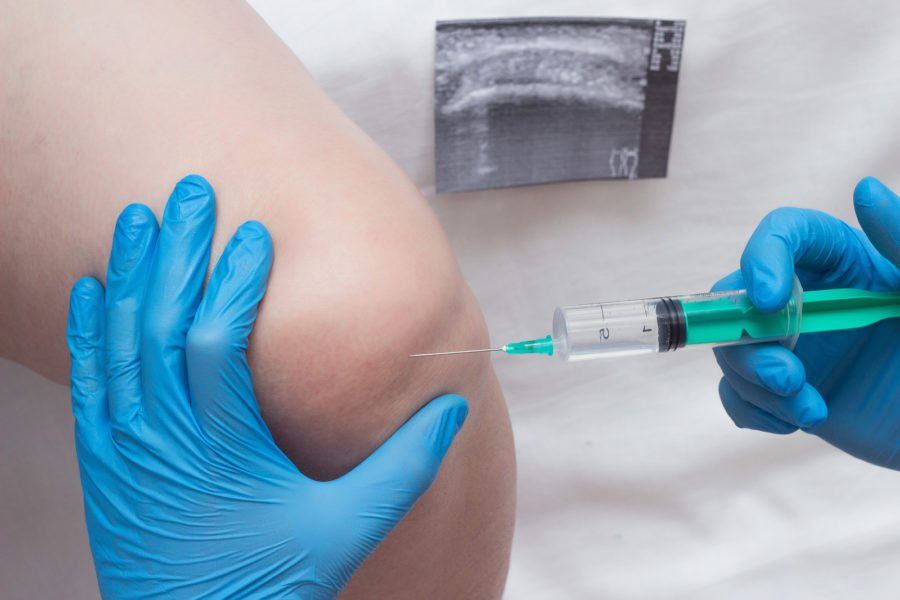What Is Cortisone?
What if the Cortisone shot doesn’t work? We need to first discuss what Cortisone is. Cortisone is a steroid. Steroids are hormones that your body produces via the adrenal glands. They have powerful anti-inflammatory properties that are used extensively in medicine (1). There are different types of steroid medications that vary by their potency, water solubility and duration of action. Common names include Depo-Medrol, Solu-Medrol, and Betamethasone. Steroids can be taken orally, injected, or inhaled.
What Does Cortisone Do to the Body?
Inflammation caused by injury or arthritis can make joints painful and daily activities difficult. Cortisone reduces this inflammation and swelling. Therefore the pain and limitation can be reduced. Unfortunately, cortisone has significant side effects which include:
- Suppresses immune function (2)
- Reduces local stem cell numbers which can compromise healing (3).
- Compromises tendon healing making them weak and more susceptible to rupture (3).
- Increases the incidence of bone death (osteonecrosis) (4).
- Alters blood glucose and insulin sensitivity.
- Aggravation in symptoms as is the case with tennis elbow. Steroid injections can make things worse (5)
- Steroids damage cartilage (6)
- Steroids kill stem cells (7). Stem cells are your repair cells and are responsible for healing and repair.
Do Cortisone Shots Always Work?
No why? There are a number of reasons why steroid shots don’t work. These include:
Missed the Target; The injection failed to get to the intended target. This commonly occurs when the injection was performed without x-ray or ultrasound guidance.
Inflammation was not the underlying problem. Steroids work by reducing inflammation. Some injuries do not involve inflammation such as a torn ACL in the knee where the principal problem is ligament instability.
Stem cells are killed. Cortisone kills your repair cells. Healing and clinical improvement can not happen when this occurs.
What if the Cortisone Shot Doesn’t Work?
What if Cortisone shot doesn’t work? If the first cortisone injection doesn’t provide pain relief, your doctor may try a second injection four to six weeks later. Albert Einstein said it best. Insanity is doing the same thing over and over and expecting different results. Regrettably, this is the approach adopted by many providers and must be avoided. Steroids have significant side effects which compromise cartilage, tendons, ligaments, and your ability to heal. Three important facts that you need to know about steroids.
- Cortisone reduces inflammation but does not heal the underlying problem.
- The results of steroids are temporary typically lasting 6-8 weeks.
- Steroids severely inhibit healing.
Is there a better, natural option? YES!
Meet SANS
SANS is a systemic approach in the diagnosis and treatment of orthopedic conditions. It stands for Symmetry, Articulation, Neurologic, and Stability. The Centeno-Schultz Clinic uses this approach as it searches for the underlying problem, or problems, that led to the injury. This is a critical point as many clinical practices focus exclusively on the reduction of symptoms. This is flawed as unless the underlying problem is identified and addressed the symptoms will recur and you will be stuck on a roller coaster of pain and limitation. Steroids are the tool of such practices as they merely reduce the inflammation and often times the symptoms. Unfortunately, steroids compromise your cartilage, tendons, and ligaments.
The Centeno Schultz Clinic is committed to your well being and success. We utilize a comprehensive approach in your evaluation to understand the underlying problem. High dose steroids are never used. Treatment options include PRP and bone marrow-derived stem cell injections which can address the underlying problem and accelerate repair and healing. Our clinical outcomes are available here.
In Conclusion
Cortisone is a steroid. Steroids are hormones that are produced by your body. They are powerful anti-inflammatory agents that are used extensively. Steroids have alarming side effects which include reducing local stem cell numbers, compromising tendon healing, increases the incidence of bone death, alteration in blood glucose, and killing stem cells. Steroid injections do not always work and should not be repeated if one fails to have a clinical response. Steroids do not heal the underlying problem, are transient in nature, and severely inhibit healing. The Centeno-Schultz Clinic uses a comprehensive approach in its attempt to identify and treat the underlying problem that caused the injury. PRP and stem cells are natural and effective alternatives to steroids that accelerate cartilage, tendon and ligament healing. If steroids have been recommended or if you are tired of repeated steroid injections with diminishing results contact us for a Telemedicine consultation. Take that step to regain your passion and freedom.
References
1. Ericson-Neilsen W, Kaye AD. Steroids: pharmacology, complications, and practice delivery issues. Ochsner J. 2014;14(2):203-7.
2.Coutinho AE, Chapman KE. The anti-inflammatory and immunosuppressive effects of glucocorticoids, recent developments and mechanistic insights. Mol Cell Endocrinol. 2011;335(1):2-13.
3.Zhang J, Keenan C, Wang JH. The effects of dexamethasone on human patellar tendon stem cells: implications for dexamethasone treatment of tendon injury. J Orthop Res. 2013;31(1):105-10.
4.Chan KL, Mok CC. Glucocorticoid-induced avascular bone necrosis: diagnosis and management. Open Orthop J. 2012;6:449-57.
5.Coombes BK, et al “Efficacy and safety of corticosteroid injections and other injections for management of tendinopathy: a systematic review of randomised controlled trials” Lancet 2010; DOI: 10.1016/S0140-6736(10)61160-9.
6.Wernecke C, Braun HJ, Dragoo JL. The Effect of Intra-articular Corticosteroids on Articular Cartilage: A Systematic Review. Orthop J Sports Med. 2015;3(5):2325967115581163.
7. Wyles CC, Houdek MT, Wyles SP, Wagner ER, Behfar A, Sierra RJ. Differential cytotoxicity of corticosteroids on human mesenchymal stem cells. Clin Orthop Relat Res. 2015;473(3):1155-64.

